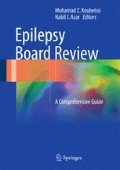Abstract
The EEG is an essential part of the initial evaluation of patients presenting with paroxysmal episodes and the surgical evaluation of patients with medically intractable seizures. The EEG is often ordered in the outpatient setting with or without concomitant video. Ictal EEG recordings are most commonly obtained in inpatient Epilepsy Monitoring Units with concomitant video, facilitating clinicoelectrographic correlations. This chapter will cover the basic morphologic features of interictal and ictal discharges and their clinical significance.
Access this chapter
Tax calculation will be finalised at checkout
Purchases are for personal use only
References
Sam M, So E. Significance of epileptiform discharges in nonepileptic patients in the community. Epilepsia. 2001;42:1273–7.
Chatrian G, et al. A glossary of terms most commonly used by clinical electroencephalographers. In: International Federation of Societies for Electroencephalographers and Clinical Neurophysiology: recommendations for the practice of clinical neurophysiology. Elsevier Science Publishers: Amsterdam; 1983. p. 11–27.
Marret S, et al. Positive rolandic sharp wave and periventricular leukomalacia in the newborn. Neuropediatrics. 1986;17:199–202.
Kellaway P. The incidence, significance, and natural history of spike foci in children. In: Henry C, editor. Current clinical neurophysiology: update on EEG and evoked potentials. Amsterdam: Elsevier; 1980. p. 171–5.
Slatter K. Some clinical and EEG findings in patients with migraine. Brain. 1968;91:85–91.
Kellaway P, Bloxom A, McGregor M. Occipital spike foci associated with retrolental fibroplasia and other forms of retinal loss in children. EEG Clin Neurophysiol. 1955;7:469–78.
Penry J, Porter R, Dreifuss F. Simultaneous recording of absence seizures with video-tape and electroencephalogrpahy: a study of 374 seizures in 48 patients. Brain. 1975;98:427–40.
Koubeissi MZ, et al. Scotosensitive myoclonic seizures in MERRF. Neurology. 2009;72(9):858.
Koubeissi MZ, et al. Medically intractable seizures originating from the primary somatosensory hand area. Epileptic Disord. 2008;10(4):339–48.
Devinsky O, et al. Clinical and electroencephalographic features of simple partial seizures. Neurology. 1988;38(9):1347–52.
Williamson PD, et al. Complex partial seizures of frontal lobe origin. Ann Neurol. 1985;18(4):497–504.
Ebersole JS, Pacia SV. Localization of temporal lobe foci by ictal EEG patterns. Epilepsia. 1996;37(4):386–99.
Laskowitz DT, et al. The syndrome of frontal lobe epilepsy: characteristics and surgical management. Neurology. 1995;45(4):780–7.
Williamson PD, et al. Parietal lobe epilepsy: diagnostic considerations and results of surgery. Ann Neurol. 1992;31(2):193–201.
Proposal for revised classification of epilepsies and epileptic syndromes. Commission on Classification and Terminology of the International League Against Epilepsy. Epilepsia. 1989;30(4):389–99.
Berg AT, et al. Revised terminology and concepts for organization of seizures and epilepsies: report of the ILAE commission on classification and terminology, 2005–2009. Epilepsia. 2010;51(4):676–85.
Panayiotopoulos CP, Obeid T, Waheed G. Differentiation of typical absence seizures in epileptic syndromes. A video EEG study of 224 seizures in 20 patients. Brain. 1989;112(Pt 4):1039–56.
Author information
Authors and Affiliations
Corresponding author
Editor information
Editors and Affiliations
Rights and permissions
Copyright information
© 2017 Springer Science+Business Media LLC
About this chapter
Cite this chapter
Koubeissi, M.Z., Azar, N.J. (2017). Ictal and Interictal EEG. In: Koubeissi, M., Azar, N. (eds) Epilepsy Board Review. Springer, New York, NY. https://doi.org/10.1007/978-1-4939-6774-2_5
Download citation
DOI: https://doi.org/10.1007/978-1-4939-6774-2_5
Published:
Publisher Name: Springer, New York, NY
Print ISBN: 978-1-4939-6772-8
Online ISBN: 978-1-4939-6774-2
eBook Packages: MedicineMedicine (R0)

